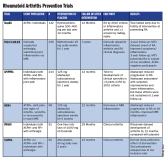News

RA Prevention: A Decade of Trials Provides Insights on What’s to Come
- Author:
- Lucy Hicks
Data from recent studies suggested improved risk stratification and understanding of disease pathogenesis are key in identifying more effective...
News
New Scanner Creates Highly Detailed, 3D Images of Blood Vessels in Seconds
- Author:
- Lucy Hicks
Researchers created a scanner that provides 3D images of vasculature, useful in RA, PVD, and cancer treatment.
News

Methotrexate in Preventing RA: Benefits in ACPA-Negative Patients, and Is It Cost Effective?
- Author:
- Lucy Hicks
ACPA–negative individuals with clinically suspect arthralgia had reduced rates of RA development when treated with a 1-year course of methotrexate...
News
FDA Approves Ustekinumab Biosimilar Otulfi
- Author:
- Lucy Hicks
This is the fourth ustekinumab biosimilar approved in the United States.
News

Bimekizumab Gains FDA Approval for Psoriatic Arthritis, Axial Spondyloarthritis
- Author:
- Lucy Hicks
The drug is the first and only dual IL-17A and IL-17F inhibitor approved to treat four chronic immune-mediated inflammatory diseases.
News

Benralizumab Now FDA Approved to Treat EGPA Vasculitis
- Author:
- Lucy Hicks
In a clinical trial, nearly 60% of participants achieved remission and 41% fully tapered off oral corticosteroids.
News

Rheumatology Clinic Interventions for Smoking, Blood Pressure ‘Make a Big Difference’
- Author:
- Lucy Hicks
Dr. Christie Bartels discussed how rheumatology clinics can be utilized to tackle two common risk factors for heart disease without adding...
News
What’s Causing Raynaud Phenomenon Severity to Rise With High Temperatures?
- Author:
- Lucy Hicks
Both extreme heat and cold were tied to more severe episodes of Raynaud phenomenon in a study of participants with systemic sclerosis.
News

Do You Have Patients With JAKne — JAK Inhibitor–Associated Acne? Here’s What to Know
- Author:
- Lucy Hicks
Janus kinase (JAK) inhibitor-associated acne may be overlooked outside of dermatology, experts said.
News
Trends in Rheumatic Disease Pain Management Show Decline in Opioid Use
- Author:
- Lucy Hicks
Since 2014, opioid use for autoimmune rheumatic decreased by 15% annually while other management modalities increased or stabilized.
News
Early RA Diagnosis and Treatment Lowers Treatment Costs
- Author:
- Lucy Hicks
Costs were as much as 316% higher in patients diagnosed and treated more than 12 weeks after symptom onset.
News

Pyzchiva Receives FDA Approval as Third Ustekinumab Biosimilar
- Author:
- Lucy Hicks
The biosimilar is approved for all indications of the reference medication, Stelara, and will launch in February 2025.
News
Form of B12 Deficiency Affecting the Central Nervous System May Be New Autoimmune Disease
- Author:
- Lucy Hicks
The findings uncover “yet another example of a disease where antibodies getting into the brain are the problem.”
News
Psoriatic Arthritis Symptoms Relieved with TYK2 Inhibitor in Phase 2 Trial
- Author:
- Lucy Hicks
More than half of patients assigned to TAK-279 achieved ACR20 at 12 weeks, compared with 30% of patients assigned to placebo in a phase 2 clinical...
News
Psoriatic Arthritis Drug Candidate Sonelokimab Yields Significant Improvements in Phase 2 Trial
- Author:
- Lucy Hicks
Patients receiving sonelokimab experienced higher treatment response in ACR20, ACR50, and PASI90 than those in the placebo group.
